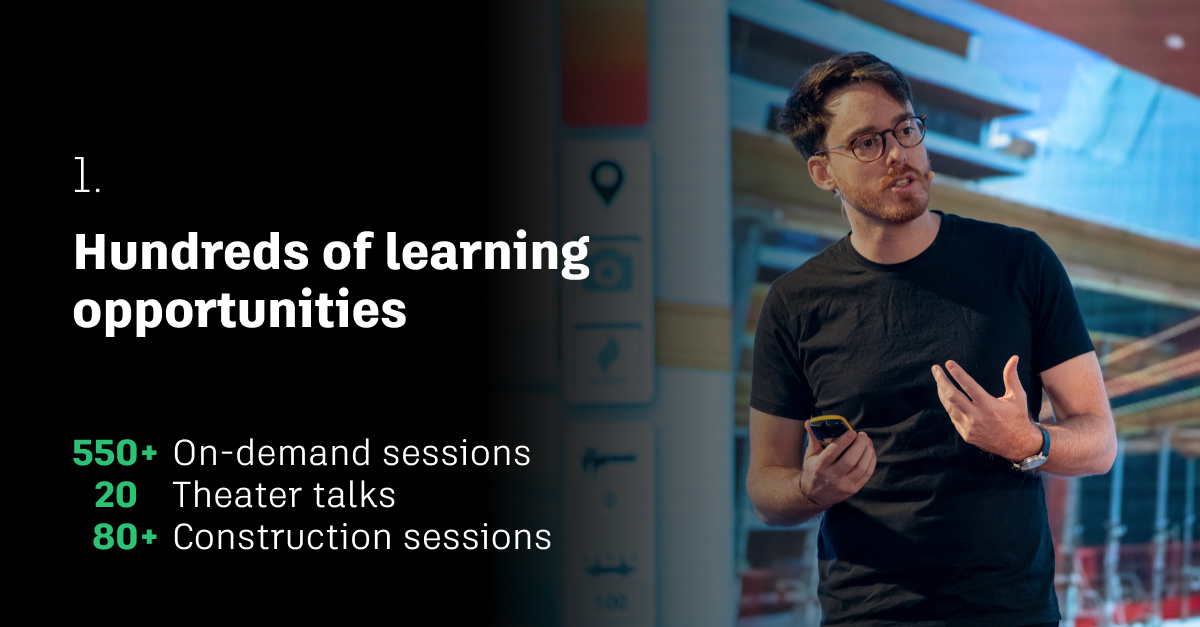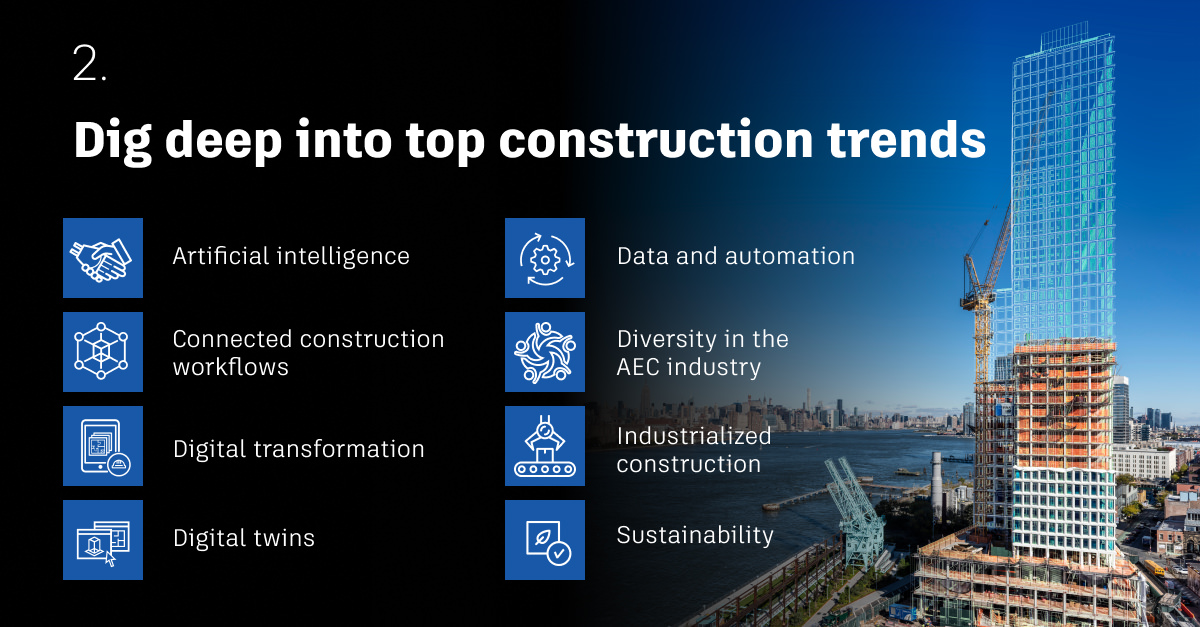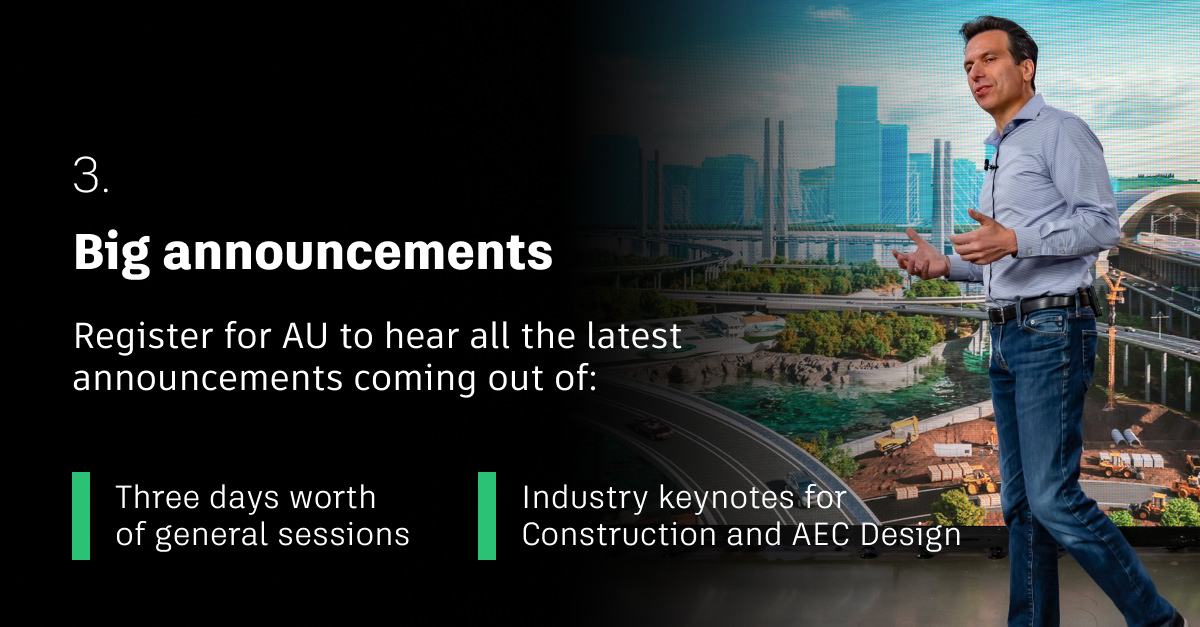Home » Construction Management (Page 8)
Category Archives: Construction Management
9 Fun Skyscraper Facts

Today, September 3, is National Skyscraper Day, chosen in honor of John H. Sullivan’s birthday, the architect who coined the phrase “form (ever) follows function” and is considered the “father of skyscrapers.”
![]()
Did you miss our previous article…
https://www.arizonasolarsociety.com/?p=455
5 Reasons Construction Pro’s Should Not Miss Autodesk University 2021
Autodesk University (AU) is back and better than ever. AU 2021 is about empowering you to take the reins and build the world you want to see. It’s why our leading mantra this year is Don’t wait for progress. Make it. And we’re here to equip you with expert-led classes, panels, meetups, workflow education, product demos, and more. Achieving your goals is our top priority. This zero-cost digital conference runs from October 5 – 7 for those in the Americas. More dates for international attendees below. This is one construction event you do not want to miss, and it only comes around once a year.
REGISTER NOW

What makes AU 2021 an absolute must for construction professionals? This event is chock full of informative insights, action plans, inspiring thought leadership, and engaging industry panels. Nowhere else will you find so many industry experts advancing architecture, engineering, construction, design, manufacturing, and media and entertainment all in one place. Did we mention it’s 100% free, virtual, and open to all?
Keep reading to discover how to make sure you maximize your time during AU and make the most of this opportunity to learn, connect, and engage.

Learn from construction’s finest
We could go on and on about just how many inspiring sessions you’ll find at AU but a quick glance at the numbers makes an even more compelling argument:
- 550+ on-demand sessions
- 20 theater talks
- 80+ construction sessions
We’re not exaggerating when we say this is the biggest learning opportunity of the year for construction professionals. AU sessions will cover popular workflows and topics including:
- Connected construction
- Preconstruction
- Construction, jobsite, and built environments
- BIM
- Industrialized construction
- Diversity & Inclusion
- Sustainability
- And more
You’ll find plenty of information on hot-button subjects such as sustainability in construction and vitally important themes like diversity and inclusion. We’re proud to share that nearly 3 out of every 4 classes at AU are customer-led. That means you’ll learn tricks of the trade from people who have deep industry knowledge and manage construction workflows for projects of all sizes.
Can’t make every session you want to attend? Not to worry. All of the content will be available on-demand. Make sure you register now for access so we can send you the schedule as soon as it’s available.
SAVE YOUR SEAT

Construction trends you should know about
For an industry that’s often characterized as “traditional,” the construction industry is always changing. It can be difficult to keep tabs on the latest developments and emerging trends such as artificial intelligence, digital twins, and industrialized construction. That’s why we’re bringing them to you in AU 2021, where you’ll learn what is happening right now and how to get on board for the future.
No matter what your role in the industry is, it’s always beneficial to keep a pulse on innovative concepts and technologies. Whether you want to secure that next promotion or drive greater ROI for your client on a large-scale project, you’ll receive the insights you need to bring you one step closer to achieving your goals.

Exciting technology and product news
At AU 2021, you’ll hear exciting news from our general sessions and our keynote with Jim Lynch, SVP & GM of Autodesk Construction Solutions. Put time on your calendar for inspiring thought leadership and insights into how we’re helping empower tomorrow’s leaders of construction—yourself included.

Get exclusive on-demand content
Think of our on-demand content like Netflix but for construction. Press play on our 15-minute theater talks and get ready to jump right into the latest information on industry and technology possibilities. These provocative talks from industry experts are designed to help you explore big ideas and inspirational projects.
AU’s explainer videos are an absolute must for anyone who wants to get into the nitty-gritty of construction. We’ll share the ins and outs of all things construction in a consumable, engaging format. They’re perfect for getting up to speed on highly technical concepts in a flash.

Connect, network, and engage
Sure, AU 2021 is virtual but that won’t stop us from bringing the brightest minds in construction together. We’re providing dozens of opportunities to connect and engage with experts throughout the conference. You’ll love our live meet-ups, which we kicked off at AU 2020, with conversations about everything from design and planning to construction and beyond.
How to make the most out of Autodesk University
Autodesk University only comes around once a year, so it’s important to make the absolute most of it! Here are our time-tested tips and tricks for maximizing your experience:
1. Register early
Did we mention this year’s theme is “Don’t Wait for Progress. Make It.”? The first step in making progress toward your goals is making sure your seat is saved at AU 2021. Don’t wait until October 5 to register. Head to the AU 2021 site now and click on the “Register Now” button. In a matter of minutes, you’ll be registered and ready to consume all of the great classes and content, both live and on-demand.

2. Plan your schedule
Once you’re registered, we’ll send you this year’s full schedule as soon as it’s available. Take a look at the keynotes, theater talks, and sessions ahead of time. Some sessions are only offering limited seating, so please make sure to sign up now so you’re among the first to hear. Once the schedule has been released, bookmark your favorite classes so you can jump right in on October 5. You can get a sneak peek of the schedule on the official AU 2021 website.
3. Make time
Once you’ve registered and picked your sessions, what’s next? Set yourself up for success by making time. Block out your work calendar so you can really immerse yourself in the learning experience. Let your team know about your attendance and invite them to join you. Share far and wide—with 39 countries represented and content in 8 languages, AU 2021 is a must-attend international event for construction professionals.
4. Make space
While this is a virtual conference, we encourage you to take stock of your environment. Do you need to swap out your headphones or adjust your monitors prior to the conference? Can you book a conference room for yourself and team members? Make things as comfortable as possible so on October 5 all you need to do is show up and learn.
The future belongs to those who make it—start building yours at Autodesk University 2021
We’re excited to see you at AU 2021, where you’ll find a wealth of industry knowledge, technology, and education. We’ve said it before, and we’ll say it again—this free, virtual conference is open to all and kicks off on October 5. So what are you waiting for?
REGISTER NOW
The post 5 Reasons Construction Pro’s Should Not Miss Autodesk University 2021 appeared first on Digital Builder.
Did you miss our previous article…
https://www.arizonasolarsociety.com/?p=430
18 firms win £220m Yorkshire civils framework
Eighteen regional contractors have secured places on a civil engineering framework for the seven councils forming the Yorkshire Highways Alliance including North Yorkshire County Council
The works for complete or part construction and civil engineering work will predominantly take place on bridges and the highway network.
Potential works include: resurfacing, reconstruction, slurry sealing, drainage and kerbing, repairs to bridges, retaining walls and culverts.

Civil Engineering Contractors Framework 2021
Projects £2m+ in North Yorkshire, York, Bradford, Calderdale, Kirklees, Leeds & Wakefield.
C.R. Reynolds; Eric Wright Civil Engineering; Fox (Owmby); Jackson Civil Engineering Group; PBS Construction (North East); Rainton Construction
Projects £500k – £2m in North Yorkshire, York, Bradford, Calderdale, Kirklees, Leeds & Wakefield.
C.R. Reynolds; Colas; Dyer & Butler; Fox (Owmby); Galliford Try Construction; I & H Brown; PBS Construction (North East); Rainton Construction
Projects: up to £500k – Bradford, Calderdale, Kirklees, Leeds & Wakefield
A E Yates; C.R. Reynolds; Cheetham Hill Construction; Hinko Construction; JN Bentley; PBS Construction (North East); Rainton Construction; Seymour Civil Engineering Contractors; Thomas Armstrong (Construction); Thomas Bow;
Projects: up to £500k – North Yorkshire & York
A E Yates; C.R. Reynolds; Cheetham Hill Construction; Hinko Construction; Howard Civil Engineering; JN Bentley; PBS Construction (North East); Rainton Construction; Seymour Civil Engineering Contractors; Thomas Armstrong (Construction)

Behind the Build: Interview with Jonathan Mabe, Assistant Project Manager, Eckardt Group
Succeeding in today’s competitive and somewhat uncertain construction landscape requires flexibility, resilience, and—let’s be honest—help from technology. To overcome major challenges, like a global pandemic, you need to have the right skills and mindset, along with tools to make your life easier.
Jonathan Mabe learned these lessons first-hand as a young assistant project manager at Eckardt Group. It’s a firm that offers a full range of electrical systems and construction techniques. In our latest Behind the Build interview, Jonathan recounts his experience in overcoming unexpected challenges when a project he was working on faced extreme weather conditions and pandemic-related issues.
Read his story below.
Tell us a little bit about Eckardt Group and what you specialize in.
We are an electrical contractor and we specialize in hospitals and data centers, so we’re more on the commercial side of things. We also do some service work, but we primarily focus on hospitals and data centers.
Walk us through your career and what led you to becoming an Assistant Project Manager.
This is actually my first real job. I went to the University of Tennessee, but haven’t graduated. I was planning on going into the Air Force. I was an officer in training, and some hiccups in the road led me to decide to take a break from college, earn more money, and get started with a career.
That’s when I hopped on board with the Eckardt Group. Since I had a leadership background in healthcare, they started me down the path to becoming a project manager. Right now, I’m an Assistant Project Manager and love every second of it.
It’s been an interesting journey. When I first got hired, we had an AT&T project in the Virgin Islands and I was fortunate enough to get put on that job. I was more in the field, just learning the ropes of the electrical trade. Unfortunately, I got sick during that time, so I decided to go back to the States, and this jump-started my project management career away from the field.
They reassigned me to the Grady Hospital in Atlanta, which is one of the main hospitals here in the city. If the President were in the Southeast region of the United States, he would be flown to Grady for any trauma emergencies.
I was at Grady at the time COVID hit and the hospital had a flood that wiped out seven floors of a certain wing. We had to renovate it and then we had to switch or convert standard patient rooms into isolation rooms for COVID. So when the pandemic happened and everyone was staying home, we were right there on the front lines at Grady and still having to work.
What project at Eckardt are you most proud of? Why?
I would say all our projects have been important. I’ve worked at a data center. I’ve worked here at Piedmont hospital, but I would definitely say the most memorable and proudest project I’ve been a part of is Grady.
At first, it was just a distinct opportunity to renovate such a historic hospital, but it evolved into something greater and more meaningful. We had to turn patient rooms into isolation rooms within just a couple of weeks, and we were able to do so in a timely manner. That was painstaking work. It required our field guys to be there 24/7 and some of the guys only had two to three hours of sleep before they had to be right back because we had a really strenuous turnaround time for these rooms.
It was hard but also very rewarding and memorable.
What are the biggest challenges you face in your role? How does technology help you meet these challenges?
I would say the most important is the standardization of files and folders and also tracking of key aspects of your job. Let’s say you have a project management team of three. What happens when a project manager or an assistant project manager gets fired or quits or goes off the grid? What happens to all their work? Well, all the information disappears if you don’t have a solution like Autodesk Build where you can standardize file and folder structures and collaborate amongst your coworkers.
One thing I like about the software is it takes things a step further. You can share files with your field teams and they can access them through their iPads in the field within seconds.
Data tracking is also extremely important. One of the biggest parts of my job is managing the flow of money. I need to make sure we make money and pay people. Tracking all that using the cost features of Autodesk Build is very helpful. We’re able to import our budgets, track change orders, and more.
We’re also using Autodesk Build to stay on top of asset tracking. When we build patient rooms, for example, all the materials required to build will come pre-packed in a cardboard box. So how do you track all that? Simple — Autodesk Build has an Asset tool that allows you to print barcodes or QR codes that you can paste on these boxes and you can set up a workflow that can be tracked.
So we can start at the build material and say, “Okay, so this kit has been bought.” From there, it has to get pushed to our prefab and we’ll say, ‘They’re starting the kit.’ And then they update the status saying it was delivered or sent. At that point, the field gets it and they’ll say when they’ve received and installed it.
There are a lot of moving parts, so having that tracking capability helps big time.
When you think about the future, what are your plans to advance innovation and productivity at Eckardt Group?
My biggest vision is to be able to automate all our processes and standardize our products. For instance, we want to streamline how we get materials on-site, particularly on the front end of the job. Right now we’re using Revit and we’re building our entire job. We want to be able to export build materials and layout drawings, which can then be processed into build materials that turn into kits that get sent to the site.
But we want that process to be automated. Right now when you need the build materials, you have to request a quote and write POs, then you need to track when the material was released to the site and when it was released to our prehab. There are a lot of moving parts, so automating everything is key.
What advice would you give to the next generation of men and women entering and preparing for the future of the industry?
There are two key things that I would impart to others. The first is to be open to criticism, but don’t be afraid to push your ideas out there. This is particularly important when you’re beginning your career, because frankly when you’re new, that’s when you have the boldest ideas.
Someone who’s been seasoned and been working for a while can be set in their ways and do things simply because that’s the way they’ve always done it. However, there could be a better way to complete a task or job, and people who are new are more open to those things.
Secondly, you need to focus heavily on being organized. This is such an important thing in our industry. If you’re not organized, things are going to get lost. Someone might miss or forget details. And when that happens, you’re going to get into trouble in some way.
Maybe you forget to order light fixtures for the job and all of a sudden the project is several months behind schedule, and you’re having to pay millions of dollars in back charges.
Being organized is key.
The post Behind the Build: Interview with Jonathan Mabe, Assistant Project Manager, Eckardt Group appeared first on Digital Builder.
GRAHAM lands £22m Camden tower recladding deal
GRAHAM has landed a £22m contract from the London Borough of Camden to reclad one of the Chalcots Estate towers.
Wates was originally lined-up for the work on the Blashford Tower but failed to agree a final price with the council.
Wates landed a £90m deal with Camden in January 2019 to reclad five towers across the estate in the wake of the Grenfell disaster.

But Wates and Camden parted company last year after failing to agree final terms.
Due to its different structure a separate two stage design and build contract has been awarded for Blashford Tower so that work can start on the building sooner than if it was part of the overall Chalcots buildings tender.
In the first stage – beginning next month – Ccuncil Officers will work with GRAHAM and technical experts to finalise the design details and test how the works will be carried out.
In the second stage of the contract – from July 2022 to December 2023 – the contractor will source materials for the works, set up the site and carry out the works, including installing an A1 rated cladding system, new windows, curtain wall and the other works needed to deliver the highest standard of safety for residents.

Councillor Meric Apak, Cabinet Member for Better Homes, said: “This is a significant step forward in delivering a new standard of resident safety for the Chalcots and I am pleased that we have reached this important milestone for Blashford with the appointment of GRAHAM.
“I share the disappointment that residents have felt about delays and so I know that they too will be pleased of this appointment and to see works getting underway.”


Site worker crushed at BAM Johnnie Walker whisky site
A worker was crushed under a lift this week at BAM Construction’s Johnnie Walker Experience site in Edinburgh.
The victim is being treated in hospital for broken ribs after the accident on Tuesday at the site where BAM is building a whisky tourist attraction for drinks giant Diageo.
A Diageo spokeswoman told the BBC: “Unfortunately a subcontractor to our principal construction partner was involved in an incident on site, becoming trapped when commissioning a low-level lift.

“Thankfully, due to quick actions of co-workers on site, the person was released quickly and given prompt first aid. The person concerned is currently in hospital with broken ribs and our thoughts are with him and his well-being.
“Our principal contractor and Diageo take the health and safety management of the site extremely seriously and all the necessary investigations are being carried out. We cannot comment further at this stage.”


A Practical Guide to Construction Accounting Software
Construction accounting software is a must-have, but may seem daunting to implement new solutions if your accounting technology hasn’t kept up with the complexities of your growing business. Managing the myriad of accounting activities across an entire construction business, or at any phase of an individual project, you’re going to want access to the most accurate, real-time numbers possible.
No stranger to disruption, the construction industry is experiencing higher levels of digitization than ever before. The pandemic has accelerated digital transformation by as much as seven years according to some experts. Technical tools and solutions are making some of the most complicated and manual practices in construction a concern of the past.
ƒThat includes accounting. Sure, accounting may have a bit of a reputation for being mundane. But the latest innovations in construction project management software provide an exciting level of financial clarity—especially useful to connect project finances to accounting decision-makers. If you’re exploring options to make construction accounting more efficient and accurate, you’ll find plenty of helpful information on choosing the right software below.
The Basics of Construction Accounting & What Makes It Different
At its most basic level, accounting helps businesses understand and capture accounting activities. It’s essential to business administration, management and financial reporting. Sometimes referred to as the “language of business,” accounting personnel document an organization’s accounting activities to accurately measure financial performance. This information is then communicated to owners, investors, creditors, and regulators. It will also dictate who you do business with and how.
Construction accounting takes into consideration the challenges that come along with the construction business. This includes tracking revenue, job costing, payroll, and managing several contracts and project risks simultaneously. Because the building process is so uniquely complex, accounting practices must be adapted to the construction industry.
Let’s look at what makes construction accounting different from most other businesses.
Everything Is Moving All the Time
The nature of construction is quite different from your average business. Outside of a major project roadblock, all aspects of a construction project are moving forward simultaneously. Instead of operating from a fixed location with a fixed set of products or services, construction projects rely on a range of locations, materials, and services. Everyone and everything tends to always be on the go. As a result, accurately managing milestones and finances throughout the life of a project—whether payables or receivables—can be challenging.
Unique Project- and Contract-Based Milestones
Firms typically work on multiple projects at a time. Instead of having one transaction, organizations may have multiple transactions occurring simultaneously across several project partners. Each project partner likely has their own set of timelines and milestones that impact accounting. Furthermore, it can take time to actually receive payment for services rendered. Some firms use project-based accounting. In this practice, each project functions as its own entity with profits and losses.
Another consideration for construction accounting is long-term contracts. It’s not uncommon for projects to take years to finish. In these scenarios, expenses and revenue may occur at different times than had been originally planned. Knowing the implications of when and how to accrue income and expenses across multi-year projects is an art in itself.
Tracking Sales
Businesses often create categories and cost codes to track sales. There are often multiple vendors on projects in construction, whether that’s to account for materials or services, there are often tens, if not hundreds, of billable line items on any given job. Traditional accounting practices leave a lot of room for error and confusion. Purpose-built construction accounting software can help to automate this process and meet the need for multiple service or product categories. Smarter categorization enables a much cleaner look at overall business performance. This is made especially easy with dedicated construction accounting software.
Industry-Specific Costs and Expenses
Every construction job involves direct and indirect costs that cross multiple categories. To make things even more complex, items that you might consider overhead expenses are often actually costs of goods sold because they are connected to a client project. Overhead costs can fluctuate month to month based on workers’ compensation, subcontractors, insurance, training, and more.
What to Include in Construction Job Costing
The complexity of construction accounting extends to calculating how much a project will actually cost the firm. That’s where job costing comes into play. This calculation method divides the project into specific tasks. That way, you can track expenses to the various tasks of a project. It provides greater visibility into which projects, activities, and materials are generating the most costs.
With job costing, you can separate the project into the main phases and then sort scopes of work into each phase. Organizations can then create unique construction cost codes to track the expenses. You may choose to create a handful of codes or multiple codes for a more granular view. After developing the codes, you can generally divide them into five categories: labor, materials, subcontracts, equipment, and overhead.
Labor
How much does your crew cost you? That’s what the labor categories in job costing can help you answer. To find this number for each project, start by calculating how much it costs per day to have your crew. This is likely to be your high level hires like general contractors, who you’ll interface with regularly. Don’t forget to include insurance, worker’s compensation, and taxes into the figure. You can then multiply the number of days you’ll have the crew on the project.
Be sure to include a buffer for unforeseen labor costs in your estimates. Project progress is rarely linear. You’ll also want to parse out subcontractor costs with the help of your general contractors. More on that below.
Materials
These costs can be both direct and indirect. For example, direct material costs can include items like concrete and steel. It’s often easier to link these items to a specific project. Indirect material costs include things like nails and caulking. You may also apply a margin for delivery and cleanup. It’s important to think of the life of a material, and any complimentary materials, when costing your project.
Subcontracts
General contractors are enlisted to manage construction activities and schedules, but are also instrumental in minimizing risks and issuing subcontracts. Each subcontract encapsulates costs for a general contractor and revenue to a subcontractor for specific scopes of work on a construction project. Managing subcontractor payment applications is fundamental to construction accounting, and also drives the upstream receivables, as subcontractor costs translate into general contractor revenue.
Equipment
Depending on whether or not your contracted labor brings equipment to the table, you may want to cost this out separately. At which point, identify your equipment supplier rates and multiply by the estimated length of the project or time needed with that particular asset. It’s possible that equipment needs will span multiple projects.
If your contracted labor does bring equipment to the table, work with them to identify expected costs for a clear picture of how your equipment impacts accounting activities over the life of a project.
Overhead
A lot of work goes on behind the scenes so you can’t forget to include the cost of doing business. That means you’ll need to measure accounting activities that go beyond the above mentioned categories. In other words, don’t forget about overhead when job costing. Some things to consider including would be full-time staff, office rentals, administration, and depreciation of equipment.
5 Steps for Revenue Recognition in Construction
Revenue recognition is the accounting of revenue when certain conditions are met on a project. Certain governing bodies issue revenue recognition standards to disseminate accounting best practices.
The Financial Accounting Standards Board (FASB) and International Accounting Standards Board (IASB) updated reporting standards for revenue recognition from contracts with customers in 2014. This standard is known as Accounting Standards Codification Topic 606 (ASC 606), or more simply, the new standard. Prior to the new standard, many organizations relied on the percentage-of-completion method and completed-contract method.
According to FASB, the intent for the latest guidance is to “report useful information to users of financial statements about the nature, timing, and uncertainty of revenue from contracts with customers.”
FASB has adopted a principle-based revenue recognition approach. With this approach, revenue is recognized according to two key factors. First, the contractor must meet performance obligations. Second, the control of goods or services must be transferred to the customer. This transfer can take place at a particular point in time or over a period of time.
To comply with revenue recognition standards, or ASC 606, be sure to follow these five steps:
- Identify the contract with the customer.
- Identify the performance obligations in the contract.
- Determine the transaction price.
- Allocate the transaction price to the separate performance obligations.
- Recognize revenue when (or as) the entity satisfies a performance obligation.
Top Construction Accounting Technologies
Dedicated construction accounting software solutions can help to optimize processes and automate manual tasks. As you consider ways to improve your construction accounting processes, keep these leading solutions in mind.
QuickBooks Online (Intuit): This cloud-based financial management software helps you manage your finances efficiently and gives you time back in your day. Create estimates, build invoices, track sales, monitor cash flow, and manage your customers as well as suppliers from one intuitive platform. Oftentimes, QuickBooks Online will be integrated with a project management platform to track costs and provide an operations team with the tools they need to control documents and manage budgets.
Morpheus: Connect any ERP to Autodesk Build’s leading budget and cost management solution for a truly integrated financial environment. No more double entry, manual errors or missed information. You gain full transparency from the field to the office on job costs. Trusted for over 20 years by the ENR 400.
DataStreet: DataStreet was built to eliminate time and material tag paperwork and reduce the amount of time spent on change order processing. The cloud-based project management platform increases transparency between your office and field teams. All of the data is stored in the cloud for easy access; use project-specific settings to customize your workflows and experience.
Rhumbix: Want to streamline your field operations? Rhumbix can do just that through easy capture of time and materials changes and construction labor costs. You’ll get all the data you need to make smart decisions about labor cost management, risk management, and safety, and they can integrate directly with accounting.
Sage: Autodesk Construction Cloud partners have built dynamic integrations between Sage 300 Construction and Real Estate and Autodesk Build, uniting accounting, project management, and field collaboration. Manage cost-related activities, streamline workflows, and connect data for greater real-time visibility into your project’s financial health.
Wrapping Up
As you can see, there’s a lot of nuances specific to construction accounting. The software solutions that exist are getting better at addressing these complexities every single day.
With the right construction accounting software, accurately job costing, tracking timelines, and adhering to the revenue recognition standards is much easier. It puts owners and contractors on the same page throughout the life of a project. Plus, the standardized approach makes tracking company-wide finances across all projects a much less daunting task.
The post A Practical Guide to Construction Accounting Software appeared first on Digital Builder.
Improve Cash Flow Forecasting with Autodesk Construction Cloud
For any business, having enough operational cash on hand is critical. Without being able to accurately forecast cash flow, making important decisions about the future of your firm or projects is a risky venture at best. So, when it comes to an industry as complex as construction—where maximizing profit and minimizing risk is the goal—accurately forecasting cash flow throughout a project’s lifecycle is essential.
The challenge with forecasting is that it’s often a time-consuming process making sense of scattered data, various spreadsheets, and multiple disconnected processes or systems. For example, some teams lean on reports from their ERP system, then look at buy-out logs and compare against schedule projections. Others rely on their scheduling team to resource load the schedule, then use the scheduling tools bell curve for analysis. In any case, the process is tedious, and by the time you’ve cobbled together all the necessary information from all the different teams, it’s easy to lack confidence in decisions relying on your cash flow forecast.
So, how can your team ensure appropriate forecasts are created to maximize profit?
The answer is Autodesk Construction Cloud. With Autodesk Construction Cloud’s cost management solution, all cost activities are centralized, and teams have the ability to connect the budget to the schedule. And now, with the newest release, Autodesk Construction Cloud improves cash flow forecasting, making it an effortless and accurate process.
Cash Flow Forecasting with Autodesk Construction Cloud
Connecting Cost & Time
Preliminaries and general conditions can vary between projects, especially items significantly affected by specific conditions like restricted access site locations and traffic management. These can typically be circa 10-20% of the project cost.
For the Contractor, there’s little price security from fixed-price Subcontracts that you get when packaging regular construction scope. That means risk is high, and contractors must plan carefully. But with few estimating systems having the functionality to assist in planning these costs, teams have to do it in spreadsheets manually, which runs a high risk of error.
Luckily, Autodesk Construction Cloud’s recently released functionality for planning these method-related management costs enables teams to plan time-based allowances in a visual way utilizing a Gantt chart view. By connecting schedule tasks to budget line items, teams can quickly determine duration then enable calculations for annual price increases. Teams can then use the pricing in the estimate submission. If successful, all the information is set up, ready for tracking and forecasting when the project begins—eliminating yet another spreadsheet from the process.
Built-In Forecast Distribution Curves
Now, with the release of phase 2 of our forecasting functionality, we have added the ability to connect the entire budget so teams can plan and track the project’s cash flow as a whole throughout the duration of the project. Four built-in forecast distribution curves are available, including front-loaded, rear-loaded, typical, and linear. With this, teams can efficiently perform forecast distributions for each budget line item.
When performing distributions to items connected to schedule tasks, dates automatically pull in, but can be altered if necessary. If needed, teams can customize the distribution further by adding or removing date ranges. In addition, teams can easily make edits within the forecast final cost field as they’re making their projections. The system will auto-flag if the distribution total doesn’t match the forecast-final cost; with a click, you can choose to have the system automatically adjust it for you—a graphic representation of the original plan versus the delta displays.
Project Level Cash Flow Analysis
Once all budget line items are forecasted, teams can access a project-level cash flow analysis in the new Forecast tool. Within this view, the information is summarized by revised budget, work completed, actual costs, and forecast-final cost, which can be viewed by period or cumulatively. This real-time summary enables teams to see planned actual and forecast quickly and provides them with the ability to quickly drill down into details if needed. Along with a table of data is a built-in dynamic time-versus-money chart, allowing teams to visualize the project-level cash flow distribution throughout the project lifecycle.
A better way with Autodesk Construction Cloud
Autodesk Construction Cloud is designed to help you make smarter, more meaningful business decisions throughout the entire construction process—from design and planning to building, handoff and operating. We make sure you can connect workflows and teams to the data they need most, when they need to make a decision. Whether that’s improving forecast accuracy, or making valuable information available to stakeholders when they need it, Autodesk has you covered.
If you’re interested in learning more about the latest updates across all Autodesk Construction Cloud products, please check out this article.
The post Improve Cash Flow Forecasting with Autodesk Construction Cloud appeared first on Digital Builder.
Did you miss our previous article…
https://www.arizonasolarsociety.com/?p=355
1,000-Word Charts: Stock Markets as of July 30, 2021

Due to its complexity, much of the subject matter concerning the economy requires detailed editorial commentary, often supported by relevant tables and graphs.
![]()
Did you miss our previous article…
https://www.arizonasolarsociety.com/?p=351
Kier restructures construction operations
Kier has restructured its UK construction operations consolidating its regions into four businesses units and a new maintenance offering branded Kier Places.
The shake-up led by Liam Cummins, group managing director for Kier Construction, who joined from Laing O’Rourke nearly two years ago, will also see two new heads appointed for two new overriding functions covering client and markets’ and operations.
Cummins said the new structure would underpin a new five-year sustainable growth plan.

“With our four regional businesses and Kier Places, we are focused on continuing to position ourselves for growth in our primary sectors and within key geographical locations, further strengthening our position as the UK’s leading regional builder.
“The creation of two new operational and client and markets’ functions allow us to unlock further potential in key markets, as well as providing operational certainty for our clients.’

“This new operating model and senior leadership team puts us in the strongest position to deliver sustainable growth over the next five years.”
Five UK Construction business units
London, South & Strategic Projects: led by David McKenzie who joined Kier last year as managing director of London & South East. This business will continue to build important healthcare and education projects, as well as maximise opportunities with the commercial sector.
Midlands & Eastern: Mark Dady’s current role as managing director for Eastern, will expand and cover the whole of the Midlands and the East of England.
Western & Wales: Anthony Irving will continue as managing director of Western & Wales and will also take overall responsibility for safety, health and wellbeing within the business.
North & Scotland: Gary Wintersgill continues as managing director for this business, which spans from Nottingham to Scotland.
Kier Places: the housing maintenance and facilities management solution business will continue to be headed up by Mark Whittaker, who has grown the business significantly over the past two years.
The two new functions are:
Clients & Markets: Louisa Finlay, formerly managing director for Kier’s Regional Building Southern business, will spearhead the newly-formed Client & Markets function. She was pivotal to defining the sustainability strategy within the Construction business and in this new position will oversee its implementation as well as supporting clients with their net zero ambitions. Finlay will also oversee Kier’s MMC offering and ‘digital by default’ approach.
Operations: Chris Stevens takes up the position as overall operations director for the Construction business. Chris joined Kier in January from Bouygues to head the old Midlands territory and will now be responsible for growing Kier’s self-delivery capabilities in building technologies and design


Did you miss our previous article…
https://www.arizonasolarsociety.com/?p=340